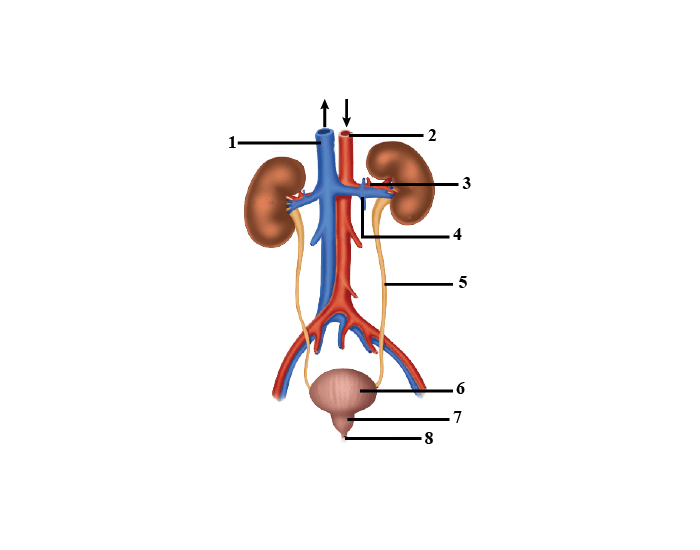What are the 4 urinary system organs?
Kidneys, ureters, bladder, and urethra
What is the definition of breathing?
Breathing, or pulmonary respiration, is the process by which the air moves in and out of the lungs. It consists in two successive stages: inhalation and exhalation
What are the 4 main components of the blood?
Plasma, red blood cells, white blood cells, and platelets.

Which organ is F?
Diaphragm
Which two kinds of blood cells do not have a nucleus?
Red blood cells and platelets
What are 2 diseases of the excretory system?
-Renal insufficiency
- Kidney cancer
- Diabetes insipidus.
- Dialysis
- Chronic kidney disease
- Kidney diseases
- Infections of the urinary tract
- Cystitis
- Urethritis
What is the role of the alveoli?
The alveoli are the site of gas exchange, where oxygen passes into the blood and carbon dioxide is removed from the blood.
What are the 4 blood types, and why are people classified into these groups?
A, B, AB, and O.
The membrane of red blood cells can contain up two different proteins, or antigens, called A and B. Depending on the antigens people have, they belong to one group or another.
Which organ removes bile pigments and other waste substances that are found in bile?
Liver
What are three respiratory system diseases?
asthma, chronic obstructive pulmonary disease (COPD), pulmonary fibrosis, pneumonia, and lung cancer, common cold, pharyngitis, tonsillitis, rhinosinusitis, rhinitis, among others.
What are the 3 stages of urine formation?
filtration, reabsorption, and secretion
How do diaphragm and intercostal muscles move during inhalation and exhalation?
They contract in inhalation and relax in exhalation.
What is the difference between an artery, a vein, and a capillary?
An artery carries oxygenated blood from the heart to the different organs. A vein carries deoxygenated blood from the tissues to the heart. A capillary are the smallest blood vessels in the body and carry blood between the arterioles and venules.
 Which organ is number 6?
Which organ is number 6?
Bladder
Name and explain both blood circulation processes.
-PULMONARY CIRCUIT: This circuit carries blood without oxygen from the heart to the lungs. The pulmonary veins return oxygenated blood to the heart.
-SYSTEMIC CIRCUIT: In this circuit, blood with oxygen, nutrients and hormones travels from the heart to the rest of the body.
What are the 3 main areas of the kidneys?
Cortex, medulla, and renal pelvis
What are the 6 airways?
nostrils, pharynx, larynx, trachea, bronchi and bronchioles.
Name one blood disease and one cardiovascular disease.
Haemophilia, anemia, leukemia
Hypertension, arterioesclerosis, myocardial infartion, atherosclerosis
Which part of the blood is reacts to bleeding from blood vessel injury by clumping, thereby initiating a blood clot?
Platelet
What is the process of urine release?
When the bladder is full of urine, stretch receptors in the bladder wall triggerthe micturition reflex. The detrusor muscle that surrounds the bladder contracts. The internal urethral sphincter relaxes, allowing urine to flow out of the bladder and into the urethra.
What is the function of the ureters?
They are two thin tubes that transport the urine formed in the kidneys to the bladder
Which organ is shared by the digestive and respiratory system?
The pharynx
What are tachycardia and bradycardia?
Tachycardia is a fast heartbeat, and bradycardia is a slow one.
Which organ is a conduit formed by rings of cartilage that is about 12 cm long and covered with mucus and cilia that trap particles left in the air and move them towards the pharynx?
Trachea
What is the lymphatic system, and what role does it play?
The lymphatic system is a network of delicate tubes throughout the body. It drains fluid (called lymph) that has leaked from the blood vessels into the tissues and empties it back into the bloodstream via the lymph nodes. It manages the level of fluid in the body.